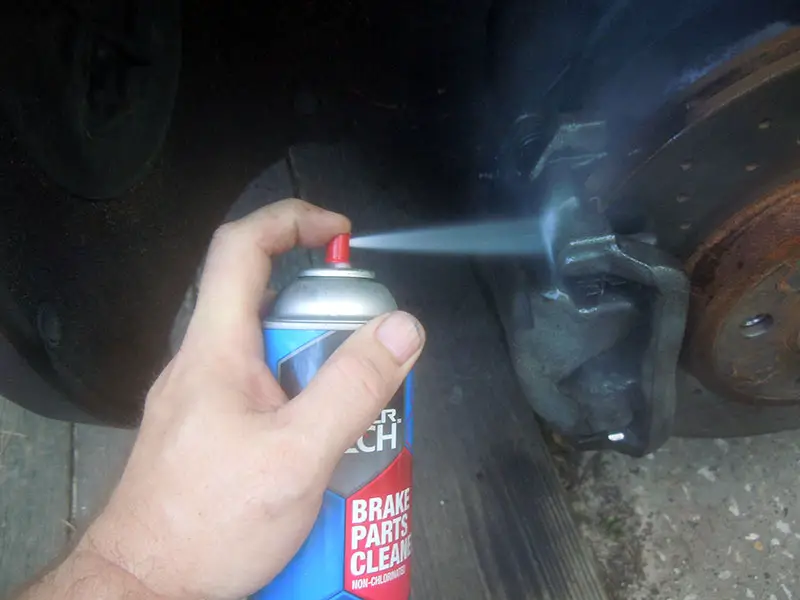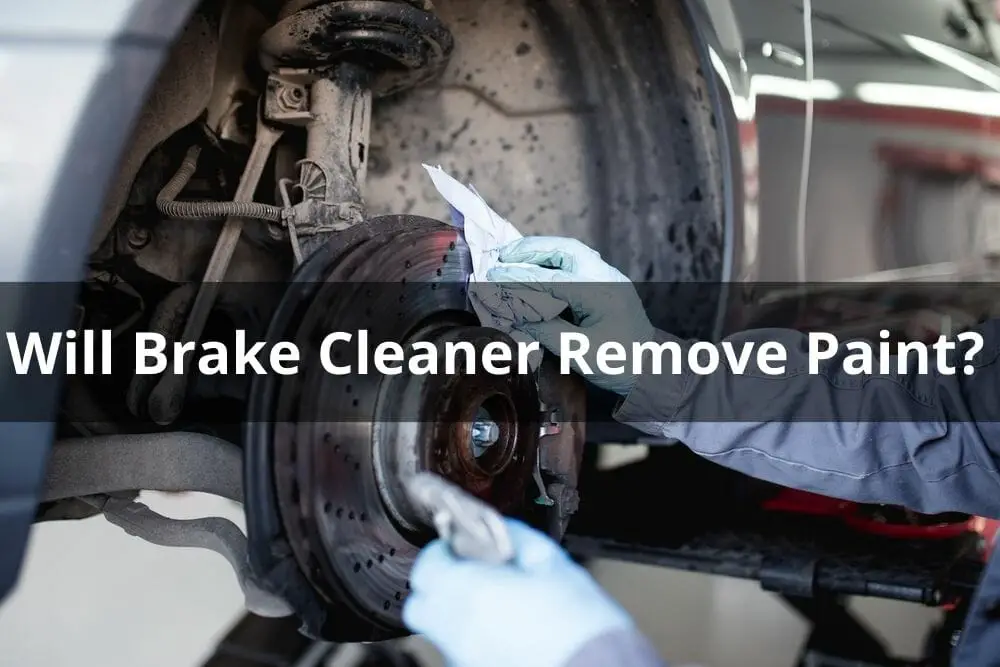Will brake cleaner remove paint? Yes, it can. Brake cleaner may strip or damage paint, especially if left on too long. Use caution around painted surfaces.
If you’ve ever found yourself working on your car or any machinery, you’ve likely reached for a can of brake cleaner. It’s the go-to for dissolving grease, oil, and grime from brake parts — fast, effective, and reliable. But many DIYers and even seasoned mechanics have asked: will brake cleaner remove paint?
The short answer: Yes, brake cleaner can remove paint — but whether it does, how much it does, and how fast it happens depends on the type of brake cleaner and the kind of paint. In this blog, we’ll dive deep into what makes brake cleaner tick, how it interacts with paint, the risks involved, and whether it should be used as a paint remover (spoiler: generally not).

Contents
- 1 How Brake Cleaner Affects Paint
- 2 Real-World Scenarios of Spraying Brake Cleaner in Paint
- 3 Types of Brake Cleaner and Their Paint Risk
- 4 Dangers of Using Brake Cleaner on Painted Surfaces
- 5 Best Practices for Using Brake Cleaner Safely
- 6 Pro Tip: How to Handle Accidental Exposure on Paint
- 7 Frequently Asked Questions
- 8 Final Thoughts
How Brake Cleaner Affects Paint
To understand how brake cleaner affects paint, we need to break down a vehicle’s paint system, which generally includes:
- Primer – bonds the paint to the surface.
- Base coat – the color coat.
- Clear coat – protects the color and gives it a glossy finish.
What Happens When Brake Cleaner Hits Paint?
Brake cleaner doesn’t differentiate between “good” grime and essential paint layers. Here’s what it can do:
- Dissolve the clear coat, making the surface appear dull.
- Soften or lift the base coat, leading to streaks or discoloration.
- Remove the paint entirely, especially if it sits for too long or if the paint is already chipped or weak.
Real-World Scenarios of Spraying Brake Cleaner in Paint
In the real world—especially in auto shops and DIY garages—this has led to a range of outcomes from minor blemishes to complete paint stripping. Let’s break down what really happens in various situations.
1. Accidental Overspray While Cleaning Brake Parts
Scenario: A DIY mechanic is cleaning brake calipers or rotors with brake cleaner, and some overspray lands on the fender.
Outcome:
- If it’s a non-chlorinated brake cleaner, and wiped off quickly, the damage might be minimal—just a dull spot or light streak.
- If it’s a chlorinated brake cleaner, it can strip the clear coat and damage the base paint within seconds.
Lesson: Always mask off surrounding areas or remove parts before cleaning.
2. Using Brake Cleaner to Remove Adhesive or Decals
Scenario: Someone uses brake cleaner to remove sticker residue from a painted surface, thinking it’ll work like Goo Gone.
Outcome:
- The brake cleaner removes the adhesive and softens the paint.
- Resulting damage can include discoloration, peeling, or etched paint that needs refinishing.
Lesson: Brake cleaner is way too harsh for delicate paint jobs-use purpose-made adhesive removers.
3. Shop Accident on a Fresh Paint Job
Scenario: A freshly painted vehicle is nearby when a tech sprays brake cleaner during a brake job.
Outcome:
- On uncured or fresh paint (within 30 days), brake cleaner causes bubbling, wrinkling, or streaks as it dissolves solvents and disrupts the curing process.
Lesson: Keep brake cleaner away from any car that’s had recent paintwork.
4. Attempting to Clean Engine Bay or Body Panels
Scenario: Someone sprays brake cleaner to clean oil or grime from a painted engine bay or door jamb.
Outcome:
- If the surface is older or has thin clear coat, brake cleaner might dull the finish or create permanent marks.
- May also damage plastic trim, rubber seals, or chrome.
Lesson: Use degreasers or all-purpose cleaners designed for automotive use.
5. “Mythbusting” or Social Media Demos
Scenario: Online videos show people spraying brake cleaner on different surfaces to demonstrate its power.
Outcome:
- These stunts usually show clear coat peeling or paint discoloring in real time.
- Depending on the brand and paint condition, damage occurs in as little as 2–10 seconds.
Lesson: It’s not a myth—brake cleaner can absolutely ruin paint.

Types of Brake Cleaner and Their Paint Risk
| Type | Paint Safety | Common Ingredients |
|---|---|---|
| Chlorinated | ❌ Very unsafe | Perchloroethylene, Methylene Chloride |
| Non-chlorinated | ⚠️ Still risky | Acetone, Heptane, Toluene |
| Eco-friendly/Low VOC | ✅ Less harsh but not paint-safe | Alcohol-based or mild solvents |
Dangers of Using Brake Cleaner on Painted Surfaces
Even if you’re trying to remove paint, brake cleaner isn’t your best option — and here’s why:
1. Damage to Adjacent Surfaces
Brake cleaner can melt plastics, strip clear coats, and ruin rubber parts in seconds.
2. Toxicity
The fumes are hazardous. Inhaling them, especially in a poorly ventilated area, can cause dizziness, respiratory irritation, or worse. Read more about the toxicity of brake cleaner.
3. Environmental Hazard
Brake cleaner contains VOCs (Volatile Organic Compounds) and must be disposed of properly. Spraying it freely is harmful to the environment.
Best Practices for Using Brake Cleaner Safely
If you’re set on using brake cleaner in your garage or shop, follow these safety tips:
- Avoid Painted Surfaces: Mask off or cover areas that shouldn’t be exposed.
- Use Gloves and Goggles: Protect your skin and eyes from splashes.
- Work in a Ventilated Area: Always use brake cleaner outdoors or in a well-ventilated garage.
- Have Soap and Water Ready: Immediately rinse any accidental overspray on paint.
- Read the Label: Different brands and formulations can vary significantly.
Pro Tip: How to Handle Accidental Exposure on Paint
If brake cleaner lands on your car’s painted surface:
- Wipe it immediately with a clean microfiber cloth.
- Rinse with water and car soap to neutralize any residue.
- Inspect the area — if the surface looks dull or discolored, apply a polishing compound.
- Reapply wax or sealant to protect the affected area.
If the damage is significant, you may need professional paint correction.
Frequently Asked Questions
Here are some FAQs about applying brake cleaner on paint –
1. Can brake cleaner remove all types of paint?
It depends on the type of paint and the surface. Brake cleaner is more aggressive on enamel and oil-based paints. However, it may not completely remove tougher automotive paints without repeated applications — and in the process, it may damage the surface.
2. Is it safe to use brake cleaner on painted wheels?
Not really. While some people use it sparingly, brake cleaner can dull or eat into the wheel’s clear coat or painted finish. Use a wheel cleaner designed specifically for painted or coated wheels.
3. What should I do if I get brake cleaner on car paint?
Act fast. Rinse the area thoroughly with water and car shampoo. If dullness or streaking appears, polish it and apply wax. If paint is lifted or damaged, professional repair may be necessary.
4. Are non-chlorinated brake cleaners safer for paint?
They are slightly less aggressive but still pose a risk. Always avoid using them on painted or delicate surfaces unless the product specifically states it’s safe for such use.
5. Can I use brake cleaner to prep a surface for painting?
In metalwork, yes — but only if you’re painting bare metal. Brake cleaner effectively removes oils and contaminants. Just ensure it doesn’t touch any remaining painted sections or sensitive parts.
Final Thoughts
Brake cleaner is a miracle product in the world of automotive maintenance — but paint-friendly, it is not. Whether it removes paint or just dulls it depends on the product and the surface — but in most cases, it will do damage. Unless you’re okay with that, keep it far from any painted surfaces and use proper products for the job at hand.
If you’re trying to remove paint, go with dedicated paint strippers or sanding. And if you’re just cleaning parts, mask everything around it to avoid costly mistakes.